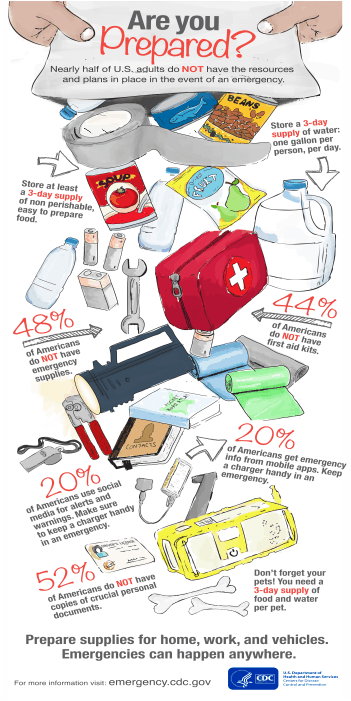Being prepared is a 3-step process.
Make note of this point: Even if the grid is hardened to maximum levels, a Carrington-class solar storm can cause Earth’s magnetosphere to “wobble” for as long as 3-9 days. This means that even in the best case scenario of a highly hardened grid, the grid could be down AT LEAST 3-9 days across the world before engineers and technicians can begin work to “black start” the grid. The U.S. civilian grid is currently not hardened.We know it is only a matter of time before our sun discharges another massive solar storm at Earth. We are in the window of time when our chances of that occurring are at 12% per decade per NASA. The next super solar storm WILL LIKELY HAPPEN in our lifetimes.
ARE YOU AND YOUR FAMILY PREPARED FOR THAT EVENTUALITY?
- First, learn about disasters that may effect you and your family.
- Second, plan how to handle the consequences of those disasters.
- Third, prepare for you and your family for those consequences.
Use your own discretion when making decisions for disaster preparedness. For many Americans, finances will limit how well and how quickly they are to able to prepare. If every family does the best they can with the financial resources they have, America will be in a much better position for any disaster, including a large scale, long-term disaster. Greater numbers of prepared families means fewer numbers dependent on the government for relief.
Knowledge without action will not protect your family in a large scale, long-term disaster. Don’t let your family be one of the masses without resources and independence.
Think “Preparedness = Insurance for Disasters.” Many Americans have car insurance and life insurance. Why not emergency and disaster insurance by way of planning and preparedness?

Governmental Resources
Links to government agencies for disaster planning are listed below. This list is not meant to be exhaustive. Please keep in mind, these agencies recommend a minimum of three to fourteen days’ supply of water, food, medications, etc. A minimum supply will only get a family through a typical disaster; grid down will not be a typical disaster.The Department of Homeland Security and FEMA continue to work at raising public awareness regarding the need for disaster preparedness. FEMA’s ‘America’s PrepareAthon’ is great place to start your family’s journey on being prepared for disasters.
DHS/FEMA: Family Communication Plan
DHS/FEMA: Food & Water (recommends 14 day supply – PDF format)
Center for Disease Control (CDC): Preparedness
ASPCA: Disaster Preparedness for Family Pets
Are you seeing a pattern here and below in the provided links? Water? Clean, drinkable water? Many Americans today do not have direct experience with a lack of potable (i.e. purified or drinking) water. For decades, clean and abundant, drinkable water has flowed from our faucets. Our grandparents’ stories of having to haul and purify water sound like quaint recollections from yesteryear; grid down will not be quaint.
In both short- and long-term disaster situations, clean drinking water should be a TOP priority. Remember: Unclean water can kill. Always error on the side of caution regarding issues of drinking water.
Many common filtration systems are not designed to purify water but merely filter (i.e. remove) particulates and other materials from water that has already been purified. A system that merely “filters” water is not capable of removing microscopic organisms that can cause illness and even death in people and animals. Water that “looks clean” can still kill.
If you plan to use a water “filtration/purification” system at home during a disaster, please be sure to carefully read the manual’s specifications to determine if it is capable of purifying water and not just merely filtering it. Also, please read over the Ready.gov and CDC websites for further information regarding water and water purification.
NGO Resources: Large Organizations & Officials
Powering Through Fragile Infrastructures to Community Resilience by Mary LaskyE-Pro Handbooks by the Electric Infrastructure Security (EIS) Council
NGO Resources: Families & Small Communities
How to Stock Your Disaster Pantry by Popular Mechanics10 Disaster Preparedness Tips You Can Really Use by Huffington Post
Water in Times of Crisis by UNICEF (as a reminder regarding unclean water)
Real Risk Management For the Electrical Grid by Jim LeBlanc
Survival Theory: A Preparedness Guide by Jonathan Hollerman

